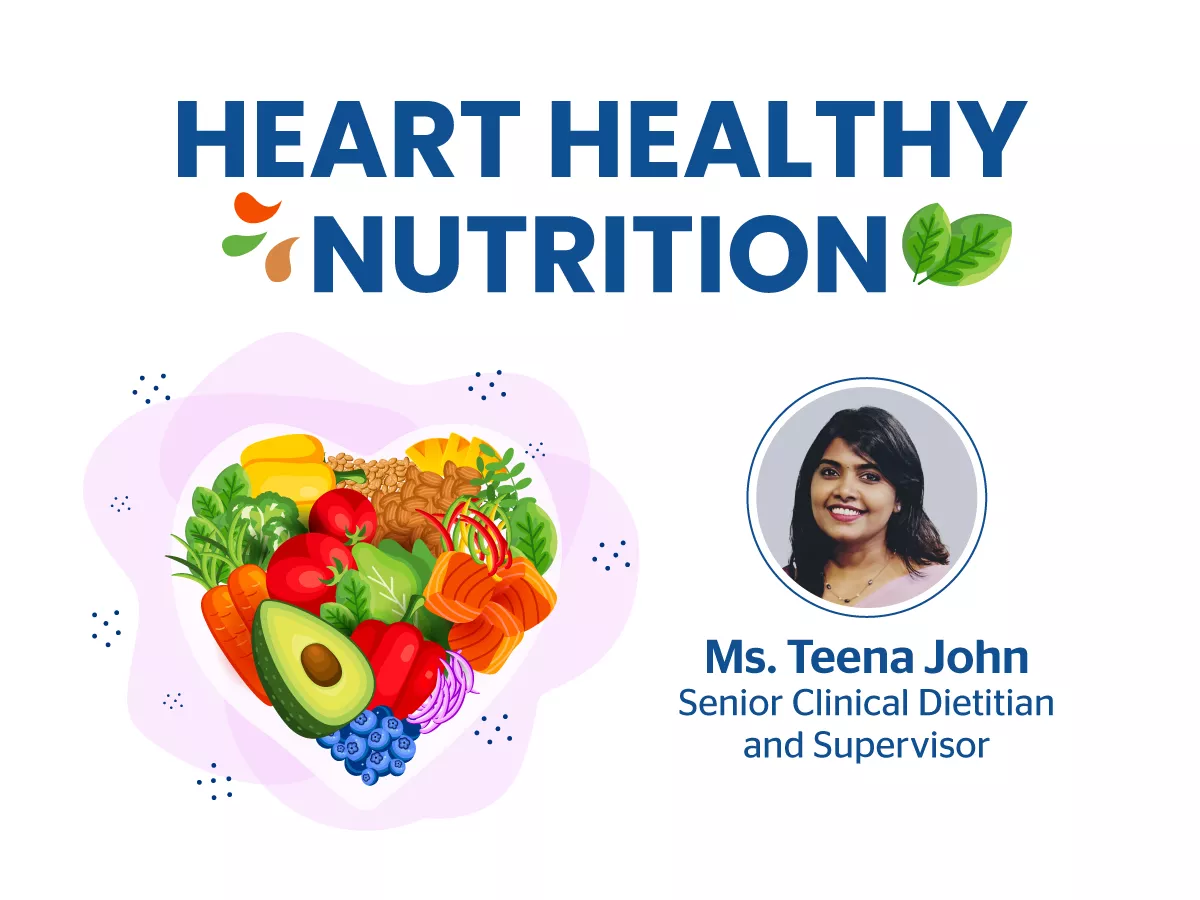Cardiovascular disease remains India’s leading cause of death. Over the last few years, health experts in India have sharpened their message: instead of focusing on a single nutrient, it's more effective to focus on a whole dietary pattern, reduce salt and industrial Trans fats, and favor minimally processed plant based foods.
Recent international guidance the American Heart Association (AHA) stresses that, diets like the Mediterranean-style or DASH diet consistently lower cardiovascular risk more effectively than focusing on a single nutrient. These patterns emphasize vegetables, legumes, nuts, whole grains, and healthy oils. Daily targets for fruits and vegetables, and a focus on limiting ultra-processed foods, as well as moderating fats and salt.
Cardiac health is a critical component of overall well-being, and nutrition plays a central role in both the prevention and management of heart disease.
A heart-healthy diet focuses on balanced nutrition-emphasizing whole grains, fruits, vegetables, lean proteins, healthy fats, and reduced sodium and added sugars. Evidence consistently shows that dietary patterns such as the Mediterranean diet, DASH diet, and plant-based approaches can significantly improve heart health outcomes.
- DASH Diet: The Dietary Approaches to Stop Hypertension (DASH) diet is highly recommended and aligns well with Indian home cooking. It emphasises fruits, vegetables, whole grains, and low-fat dairy while significantly restricting sodium.
- Mediterranean-style Diet: This pattern is associated with reduced cardiovascular risk. It is rich in plant-based foods, healthy fats like olive oil and nuts, and includes moderate amounts of lean protein. A healthy plant-based Indian diet can be similar.
- The healthy plant-based diet: A healthy plant-based diet has been shown to be associated with lower cardiovascular risk. Plant-based diets, a diet consistently of predominantly plants, can be diverse in content, patterns, and even have subsets. The subsets branch into vegetarian (which excludes meat, poultry, seafood, and fish) and vegan (in which all animal food and their products are eliminated from the diet).
- The ACC/AHA prevention guidelines discussed reducing added sugars and minimizing sugar-sweetened beverages, as added sugars have been associated with increased risk of T2D, obesity, and CVD. Additionally, they suggests prepare foods with little or no added salt, and to choose minimally processed foods instead of ultra-processed foods. As for alcohol intake, the guidelines do not support initiation of alcohol intake for cardio-protection, and to limit alcohol if one does choose to drink. Although moderate alcohol intake of 1–2 glasses per day has been associated with low risk of CHD and ischemic stroke, the evidence behind this is not strong, and some data suggest any alcohol intake, even one glass, is associated with increased risk of atrial fibrillation.
Steps to prevent heart disease
You might know that eating certain foods can raise your heart disease risk. Even though changing your eating habits can be tough, you can take simple steps to get started today. Whether you've been eating unhealthy for years or you simply want to fine-tune your diet, here are eight heart-healthy diet tips. Find out which foods to eat more of and which foods to limit. You'll soon be on your way toward a healthier diet for your heart.
1. Control portion sizes
Follow a few simple tips to control food portion size. Use a small plate or bowl to help control your portions.
• Eat more low-calorie, nutrient-rich foods such as fruits and vegetables.
• Eat smaller amounts of high-calorie, high-sodium foods. These include refined, processed and fast foods.
2. Eat more vegetables and fruits
Vegetables and fruits are good sources of vitamins and minerals. They're also low in calories and rich in fiber. Vegetables and fruits, like other plants or plant-based foods, contain substances that may help prevent heart disease. Eating more fruits and vegetables also may help you eat less high calorie food. Some examples of high-calorie foods are meat, cheese and snack foods.
Keep these ‘red’ foods in daily diet
- watermelon: Hydrates the body and contains lycopene.
- Beetroot: Boosts healthy blood flow and helps to lower blood pressure
- Tomatoes: Packed with lycopene and beneficial for both heart and skin health
- Strawberries: Rich in anti0oxidantsVitamin-C for cardio vascular protection
- Cherries: Fight against inflammation and support a healthy heart rhythm
- Raspberries: High in fibre and polyphenols, which directly protects the heart.
3. Choose whole grains
Whole grains are good sources of fiber and other nutrients that play roles in heart health and controlling blood pressure. You can get more whole grains by making simple swaps with refined grain products. Or try a whole grain you haven't had before. Healthy choices include whole-grains, quinoa and barley.
Grain products to select Grain products to limit or avoid
• Whole-wheat flour.
• Whole-grain bread, preferably 100% whole-wheat bread or 100% whole-grain bread.
• High-fiber cereal with 5 g or more fiber in a serving.
• Whole grains such as brown rice, barley and buckwheat (kasha).
• Whole-grain pasta.
• Oatmeal (steel-cut or regular). • White, refined flour.
• White bread.
• Muffins.
• Frozen waffles.
• Biscuits.
• Quick breads.
• Cakes.
• Pies.
• Egg noodles.
• Buttered popcorn.
• High-fat snack crackers.
4. Limit unhealthy fats
Limit the amount of saturated and Trans fats you eat. This helps lower your blood cholesterol and lower your risk of a common heart condition called coronary artery disease. A high blood cholesterol level can lead to a build-up of plaques in the arteries, called atherosclerosis. And that can raise the risk of heart attack and stroke.
The American Heart Association offers these guidelines for how much fat to include in a heart-healthy diet:
Check the food labels of cookies, cakes, frostings, crackers and chips. These foods are low on nutrition. And some of them — even those labelled reduced fat — may contain trans fats. Trans fats can no longer be added to foods in the United States. But they could be in products made in other countries. Trans fats may be listed as partially hydrogenated oil on the ingredient label. Also, many of the partially hydrogenated fats or trans fats typically contained in desserts and snack foods have been replaced with saturated fats. So it's still a good idea to limit those foods.
Fats to select Fats to limit
- Olive oil.
- Canola oil.
- Vegetable and nut oils.
- Margarine, trans fat free.
- Nuts and seeds.
- Avocados.
- Butter.
- Bacon fat.
- Gravy.
- Cream sauce.
- Non-dairy creamers.
- Hydrogenated margarine and shortening.
- Cocoa butter, found in chocolate.
- Coconut, palm, cottonseed and palm kernel oils.
- All processed foods
When you use fats, choose unsaturated ones. There are two main types. Monounsaturated fats are found in products such as olive oil or canola oil. Polyunsaturated fats are found in certain fish and in avocados, nuts and seeds. When used in place of saturated fats, unsaturated fats may help lower your total blood cholesterol. But it's still important to limit how much of these fats you eat. All types of fats are high in calories.
An easy way to add healthy fat -and fiber -to your diet is to use ground flaxseed. Flaxseeds are small brown seeds that are high in fiber and healthy fats called omega-3 fatty acids. Studies have shown that flaxseed lowers unhealthy cholesterol levels in some people. You can grind flaxseeds in a coffee grinder or food processor. Then stir a teaspoon of the ground flaxseed into yogurt, applesauce or hot cereal.
5. Choose low-fat protein sources
Lean meat, poultry and fish; low-fat or fat-free dairy products; and eggs are some of the best sources of protein. Choose lower fat options, such as skinless chicken breasts rather than fried chicken patties. And choose skim milk rather than whole milk.
Fish is healthier than high-fat meats. Certain types of fish are rich in omega-3 fatty acids, which can lower blood fats called triglycerides. You'll find the highest amounts of omega-3 fatty acids in cold-water fish, such as salmon, mackerel and herring. Other sources are flaxseed, walnuts, soybeans and canola oil.
Legumes- beans, peas and lentils also are good low-fat sources of protein. They contain no cholesterol, making them good substitutes for meat. Eating plant protein instead of animal protein lowers the amounts of fat and cholesterol you take in. It also boosts how much fiber you get.
Proteins to select Proteins to limit or avoid
- Low-fat or fat-free dairy products, such as skim or low-fat (1%) milk, yogurt and cheese.
- Eggs.
- Fish, especially fatty, such as salmon.
- Skinless poultry.
- Legumes.
- Soybeans and soy products, such as soy burgers and tofu.
- Lean ground meats.
- Full-fat milk and other dairy products.
- Organ meats, such as liver.
- Fatty and marbled meats.
- Spareribs.
- Hot dogs and sausages.
- Bacon.
- Fried meats.
6. Limit and reduce sodium and salt
Sodium is a mineral. It’s found naturally in some foods, such as celery or milk. Food makers also may add sodium to processed foods, such as bread and soup. Eating foods with lots of added sodium can lead to high blood pressure. So can using table salt, which contains sodium.
High blood pressure is a risk factor for heart disease. Limiting salt and sodium is a key part of a heart-healthy diet. The American Heart Association recommends that adults:
- Have no more than 2,300 milligrams (mg) of sodium a day. That's about a teaspoon of salt.
- Ideally have no more than 1,500 mg of sodium a day
Limiting the amount of salt you add to food at the table or while cooking is a good first step. But much of the sodium you eat comes from canned or processed foods. These include soups, baked goods and frozen dinners. Eat fresh foods and make your own soups and stews to lower the amount of sodium you eat.
Low-sodium items to select High-sodium items to limit or avoid
- Herbs and spices.
- Salt-free seasonings
- Prepared meals with reduced sodium or no added salt.
- Reduced-sodium versions of condiments, such as reduced-sodium soy sauce and reduced-sodium ketchup.
- Table salt.
- Canned soups and prepared foods, such as frozen dinners.
- Condiments such as ketchup, mayonnaise and soy sauce.
- Restaurant meals.
- Pickles
- Pappads
- Salted nuts and seeds
- All processed and packed foods
This scientific statements outlines dietary patterns and nutrition aiming to enhance cardiovascular health and reduce cardiovascular risk. Overall, everyone should focused plant-based dietary patterns, as unrefined as possible, rich in vegetables and fruit; Mediterranean, DASH, or vegetarian (non-vegan) diets; high dietary potassium intake. On the other side, discourage dietary patterns rich in ultra-processed foods, meat and saturated fat, skipping breakfast or snacking between meals, and increased sodium consumption. Consumption of one unit of alcohol might reduce cardiovascular risk, should focus on reducing alcohol consumption and should not motivate their patients to start drinking as a preventive measure towards CVD prevention.





